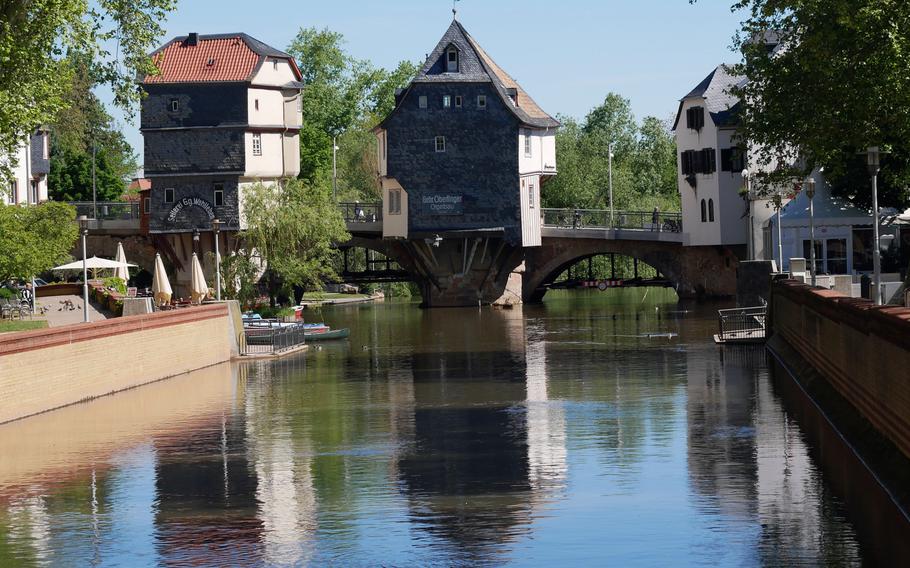
Bad Kreuznach's most famous sight is the old bridge over the Nahe with its Brueckenhaeuser, or bridge houses. The bridge was built around 1300 and the houses about 200 years later. (Michael Abrams/Stars and Stripes)
Looking for a place where you can squeeze in a hike, enjoy a spa and do some sightseeing all in a day?
Bad Kreuznach, on the Nahe River, might be just the place.
First, a little history: The Celts lived in the area, and so did the Romans. Like many towns in Germany it changed hands many times over the centuries. For a long time it belonged to the counts of Sponheim, who did much of the medieval building here.
The Swedes occupied Bad Kreuz-nach during the Thirty Years War, and the French later sacked it. The U.S. Army had a long history in the city following World War II, with the 3rd Armored Division, 8th Infantry Division and 1st AD among the units stationed here before leaving in 2001.
The center of Bad Kreuznach has two distinct quarters, the old town and the spa district.
The heart of the old town and its most popular sight is the 700-year-old Alte Nahebruecke, the bridge over the river with houses standing on it, the so-called Brueckenhaeuser.
It actually spans the Muehlenteich, an arm of the Nahe. The north end was destroyed in World War II and replaced with a modern bridge.
From the bridge you see St. Paul’s Church, built in 1332, and its 18th-century baroque tower. It was once the only building on the island formed by the Nahe and the Muehlenteich. Today the island is the center of the spa district.
From here you also have a view of the Kauzenburg, today a hotel, but not a good example of a reconstruction of a medieval fortress.
While walking through Bad Kreuznach, be on the lookout for some of its fountains and sculptures. On the Kornmarkt, where a farmers’ market is held twice a week, stands the Corn Market Fountain that depicts well-known citizens of the town’s past topped by Marie Probeck, who alerted the townspeople with her horn when fires broke out. Next to St. Nicholas church is a sculpture that looks like a golf ball on a tee, but a closer look shows fish on the ball, marking the spot where a fish market was once held.
The town’s saline springs were first mentioned in the 15th century. Later, salt walls were built, and salt was won from the springs. In the early 19th century, the healing powers of the saline springs were discovered and Bad Kreuznach became an international spa town.
The Crucenia thermal spring baths, the center of today’s spa quarter, features three saltwater pools and one freshwater pool for rest and relaxation.
There are many marked walking trails in and around the city, but one — the Panoramaweg — takes you past the town’s sights, the Kauzenburg with a great view of the town, and through the vineyards with a view of the baths.
It was the Romans who brought viniculture to the Nahe valley, so if you get a chance, give a Nahe wine a try.
Another nice stroll is along the banks of the Nahe. Walk far enough and you come to Salinental, an area that features numerous brine graduation towers.
Originally these constructs were used to produce salt. Today they are used as inhalatoriums. Visitors inhale the saline vapors, which supposedly clear the respiratory system.
Below the castle is Schlosspark Gardens, which features three museums — the Schlosspark, the Roemerhalle with Roman artifacts, and a puppet museum.
But that’s for another Quick Trip.
DIRECTIONS: Bad Kreuznach is in west-central Germany. From the Kaiserslautern area, take autobahn A63 to A61 and exit at Bad Kreuznach. For a scenic drive, take A63 to Winnweiler, then highway B48 north to Rockenhausen and on to Bad Kreuznach. From the Wiesbaden area, take A60 toward Bingen, then A61 toward Ludwigshafen, exiting at Bad Kreuznach.
TIMES: The Crucenia Thermen is open from 8 a.m. to 9 p.m. daily. The farmer’s market on the Kornmarkt is Tuesday and Friday mornings.
COSTS: Parking in most of the city’s parking garages is 50 euro cents per half-hour. Four hours at the Crucenia Thermen costs 8.50 euros for adults and 4.80 euros for children 3 to 15 years of age.
FOOD: There are plenty of restaurants in all price classes downtown and in the spa quarter.
INFORMATION: The city’s tourism website is bad-kreuznach-tourist.de/en, and the site for the thermal baths is crucenia-thermen.de. The tourist office is next door to the baths.